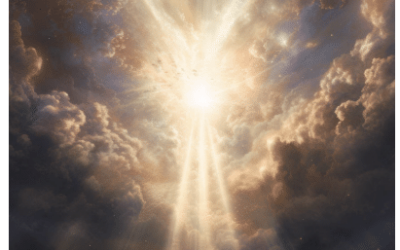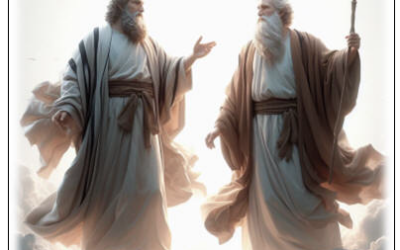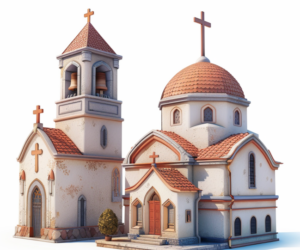All four gospels report that, when Jesus was baptized by John the Baptist, the Holy Spirit descended upon Jesus in the visible form of a dove, (Matthew 3:16, Mark 1:10, Luke 3:22, John 1:32). This event is so familiar to most Christians that the dove has become a recognized symbol for the person or presence of the Holy Spirit. Yet, if we pause to ask “why a dove?” the answer is not altogether obvious. Indeed, even in the ancient church, some false teachers exploited this to devise a system of numerology using the letters of the Greek word for “dove” to claim that God chose this image to cryptically promote their esoteric teaching.1 While such claims as these are obviously nonsense, we are left with the question: why did God choose for the Holy Spirit to appear as, of all things, a dove? The Bible never comes right out and tells us the answer, but both Scripture and history provide a few possible reasons worth considering.
A symbol of innocence and purity?
Most people assume that the dove was a symbol of something like peace, gentleness, or innocence. It certainly means such things in our culture. But is there any evidence that the first-century Jews who were present for this event would have understood the image of a dove in this way? And if they did, what would that imply about Jesus?
There is, indeed, some evidence in the gospels themselves that a dove could symbolize purity or innocence. Later in his gospel, Matthew reports Jesus instructing His disciples to “be shrewd as serpents and innocent as doves” (Matthew 10:16). Doves are also singled out as sacrificial animals in all four gospels (Matthew 21:12, Mark 11:15, Luke 2:24, John 2:14, 16), implying their representative status as a “clean” animal, pure and acceptable for sacrifice. And this may, indeed, be the point. Perhaps the Holy Spirit descended on Jesus in the form of a dove as a symbol of His sinless innocence and purity, testifying to His worthiness to be the once-for-all sacrifice and to bear the sins of humanity.
At first this might seem like a stretch, but it is conceivable that this is what the gospel writers had in mind. After all, in John’s gospel, John the baptist recounts the story of the Holy Spirit descending as a dove at Jesus’ baptism to explain his statement, “Behold, the Lamb of God who takes away the sin of the world!” (John 1:29). And each of the other three gospels follows their account of Jesus’ baptism immediately with the Spirit leading Jesus into the wilderness to be tempted by Satan (and to overcome these temptations without sin.) Perhaps the message was the same as the author of Hebrews would later write:
“Therefore, since we have a great high priest who has passed through the heavens, Jesus the Son of God, let us hold fast our confession. For we do not have a high priest who cannot sympathize with our weaknesses, but One who has been tempted in all things as we are, yet without sin. Therefore let us draw near with confidence to the throne of grace, so that we may receive mercy and find grace to help in time of need,” (Hebrews 4:14-16).
The people gathering at the Jordan to receive baptism from John were answering the call to repent and seek cleansing from the Lord. It would be a fitting context for the declaration that Jesus is the pure and sinless one who would truly bestow that cleansing. This explanation is consistent with the immediate context as well as the wider New Testament teaching. Yet, there is historical evidence that the Jews present there may have seen something different (or at least something more) in the image of the dove.
The dove and Israel
Ancient Jews often saw the dove as a symbol of the people of Israel. This tradition is not directly attested in the New Testament, but likely goes back at least that far back in time as we find it in a late first-century Jewish apocryphal book often known as 4 Esdras:
“and from all the birds that have been created you have named for yourself one dove, and from all the flocks that have been made you have provided for yourself one sheep, and from all the multitude of peoples you have gotten for yourself one people; and to this people, whom you have loved, you have given the law that is approved by all.” (4 Esdras 5:27)2
Based on later rabbinic sources (which were written down centuries after the time of the New Testament and must always be used with caution when trying to determine what first-century Jews believed), this tradition seems to have been derived primarily from two Old Testament passages. The first of these is Psalm 68:14. For example, the Babylonian Talmud several times reports:
“What is different about a dove…The Gemara answers: Because the community of Israel is likened to a dove, as it is written: ‘The wings of a dove, covered in silver, and its pinions with the shimmer of gold,’ (Psalms 68:14).”3
The Targum (or interpretive Aramaic paraphrase) of the Psalm affirms this interpretation, and it is likewise found elsewhere in rabbinic literature.4 This connection between the dove and Israel is reinforced by the common allegorical interpretation of Song of Solomon which sees the book as symbolic of the covenant relationship between God and His people. In Song of Solomon, the beloved is often addressed as “my dove,” (Song of Solomon 2:14, 5:2, 6:9). Rabbinic literature interprets this as referring to Israel,5 and thus, again, sees the dove as the symbol of the covenant people.
If this tradition was present in the minds of those Jews who witnessed Jesus’ baptism, they may have seen the heavenly dove descending on Christ as “the acknowledgment of Jesus as the ideal Israelite, the representative of his people.”6 Such would point to Jesus as the Messiah (more on this below) and also perhaps to His priestly function. Indeed, if we let the rabbinic traditions speak further, it is interesting to see some of the reasons the Jewish sages offered for why these Old Testament texts chose the image of a dove for Israel. In Midrash Tanchuma. we read:
“All other birds move convulsively while being slaughtered, but the dove alone stretches out its neck. Similarly, no nation in the world but Israel permits itself to be destroyed in order to sanctify His name.”7
And:
“Just as the dove brought light to the world (by bringing Noah an olive leaf), so you, who are compared to a dove, must bring olive oil and kindle lamps before Me.”8
Thus, at least in the minds of later Jewish Rabbis, the dove symbolized both a willingness to offer oneself up to die and also a role to bring light to the world through priestly service. If anything like these traditions goes back to the time of the gospels (and I cannot stress enough that this is a big if) the symbol of the dove would have richly represented much about who Jesus was and what he came to do. And yet, so far, these traditions largely point to the same essential meaning that we already saw in the simpler definition originally offered: the image of the dove pointed to Jesus as the pure sacrifice and innocent, worthy high priest who could take away the sins of the people.
“Descend like a dove” and the royal throne
There is perhaps one more layer to this tradition that is worth briefly noting. As a symbol for Israel in general, the dove also became connected with traditions related to the royal line of David and the promise of the Messiah. One good example of this is the tradition of Solomon’s throne. There are several versions of this with slight variations between them, but the story goes that Solomon had an ornate royal throne, and on that throne, there was a dove grasping a hawk representing the promised time when God would deliver the nations to Israel9 (i.e., the messianic age). Some versions also have the dove place the crown on the king’s head and/or the scroll of the Law of Moses in his hand. Thus, the descending of a dove from heaven to rest upon Jesus may have conjured up cultural images of the Davidic kings crowned by a dove, the dove who clutched the hawk of the nations. In other words, it may have pointed to a divine recognition from heaven that this Jesus was the Messiah who would bring about the promises of God.
This would pair well with a voice from heaven calling out “You are My beloved Son,” (Mark 1:11, Luke 3:22), which would have inevitably called to mind the Messianic prophecy of Psalm 2:10
“I will surely tell of the decree of the Lord: He said to Me, ‘You are My Son, Today I have begotten You. ‘Ask of Me, and I will surely give the nations as Your inheritance, And the very ends of the earth as Your possession,” (Psalm 2:7-8).
Thus, the descent of the Spirit as a dove may have been a culturally significant affirmation of Jesus as Messiah king! Indeed, one Midrashic source seems to indicate that creation itself was pointing forward to this moment. Genesis Rabbah offers several rabbinic interpretations of Genesis 1:2, which reads:
“The earth was formless and void, and darkness was over the surface of the deep, and the Spirit of God was moving over the surface of the waters,” (Genesis 1:2).
According to Genesis Rabbah, Simeon ben Lakish (a rabbi from admittedly after the time of the New Testament) interpreted this verse as cryptically prophesying a succession of kingdoms. Formless (Babylon), void (Medes/Persians), darkness (Greece), and “the surface of the deep” (“this wicked state,” presumably Rome). He then said that the Spirit of God hovering is “the Spirit of Messiah,” and the waters symbolize repentance. Genesis Rabbah then reports the separate testimony of Simeon ben Zoma, who pointed out that the Spirit did not blow on the waters but rather hovered over them, “like a bird flying and flapping with its wings.”11 (A similar account of Simeon ben Zoma’s words is found in Babylonian Talmud. 12)
Interestingly, Simeon ben Lakish’s scheme is clearly alluding to Daniel 7 and the vision of the four beasts followed by the “Son of Man,” a title Jesus used for Himself often. If we put the two traditions together (as the collector of Genesis Rabbah did) we see the Spirit of the Messiah hovering over the waters of repentance like a bird flapping its wings. This sounds an awful lot like the scene of Jesus’ baptism! This last example is very likely too late to have any direct relevance to the details of exactly how the Jews of Jesus’ day understood the Holy Spirit descending as a dove, but it does illustrate just how rich in meaning this scene might have been to those ancient Jewish eyewitnesses.
Conclusion
The New Testament writers clearly understood the dove as a clean sacrificial animal that could symbolize purity and innocence, and this may be sufficient to explain why the Holy Spirit chose that image at Jesus’ baptism. At least one non-biblical Jewish document from the first century provides evidence that the symbol of the dove may have carried additional meaning to the Jews of that day, and later Jewish writings expound on this possibility. This may indicate that the image of the descending dove provided an even richer testimony of Jesus to the original audience.
However, this is a lot of material to just assume without any plain statement of the New Testament to imply its relevance. The vast majority of these traditions are attested only in documents written centuries after the gospels and are often even attributed to rabbis who lived at a later date. We should not uncritically smuggle all of this material into our understanding of the New Testament. That is not the point here. Certainly, at least some if not all of these rabbinic ideas did not yet exist when Jesus was baptized, and God’s choice to have the Holy Spirit appear as a dove may not allude to any of them. But through a study like this, we do see that the dove was actually a very rich symbol to the Jewish people. When the Holy Spirit descended upon Jesus specifically as a dove, it obviously pointed to who Jesus was as the Messiah. We have good reason to think that it spoke to His sacrificial and priestly role and some evidence that it also identified Him as the Davidic king. It is interesting that over time, as later traditions developed in the non-Christian Jewish community, these traditions seem ironically and unintentionally to further emphasize the potency of the heavenly testimony at Jesus’ baptism to exactly who Christ really is.
References
| 1↑ | Noted in an ancient Christian treatise often (though likely incorrectly) attributed to Tertullian: Against All Heresies, Chapter 5, https://ccel.org/ccel/tertullian/against_all_heresies/anf03.v.xi.v.html (Accessed 11/22/2021) |
|---|---|
| 2↑ | This book is also known as 2 Esdras in some translations |
| 3↑ | Babylonian Talmud, Berakhot 53b https://www.sefaria.org/Berakhot.53b?lang=bi (Accessed 11/20/2021), see also Shabbat 130a https://www.sefaria.org/Shabbat.130a.17?lang=bi (Accessed 11/20/2021) and Shabbat 49a https://www.sefaria.org/Shabbat.49a.6-8?lang=bi (Accessed 11/20/2021) |
| 4↑ | For example, in the Babylonian Talmud, see Gittin 45a, Sanhedrin 95a, Sotah 11b which also claim the dove as an image for the Jewish people based on the same Psalm. |
| 5↑ | See, for example, Bamidbar Rabbah 4, Shir HaShirim Rabbah 2, Midrash Tanchuma: Kedoshim 12, etc. |
| 6↑ | Marvin R. Vincent, Vincent’s Word Studies of the New Testament, Vol. 1 (Macdonald Publishing Company, 1887) 27 |
| 7↑ | Midrash Tanchuma, Tetzaveh 5 https://www.sefaria.org/Midrash_Tanchuma%2C_Tetzaveh.5.5?ven=Midrash_Tanhuma-Yelammedenu,_trans._Samuel_A._Berman&lang=bi&with=all&lang2=en (Accessed 11/20/2021) |
| 8↑ | Ibid |
| 9↑ | For example, see Targum Sheni, Chapter 1. The translation of Bernard Grossfeld in “The Aramaic Bible, Volume 18: The Two Targums of Esther” (Liturgical Press, 1991) also contains notes documenting numerous instances of similar traditions in other rabbinic literature |
| 10↑ | For a separate discussion of early Christian writers and scribes who made this very connection (and of modern critics who exploit them to attack the New Testament), see our article: Did Early Christians Change the Words of Luke 3:22? |
| 11↑ | Genesis Rabbah 2:4, quotes here are from the translation of Dr. H. Freedman, Midrash Rabbah: Volume 1, third impression (The Soncing Press, 1961) 17-18, https://archive.org/details/RabbaGenesis/page/n63/mode/2up?view=theater (Accessed 11-20-2021) |
| 12↑ | Chagigah 15a https://www.sefaria.org/Chagigah.15a.3?lang=bi (Accessed 11/21/2021) |






